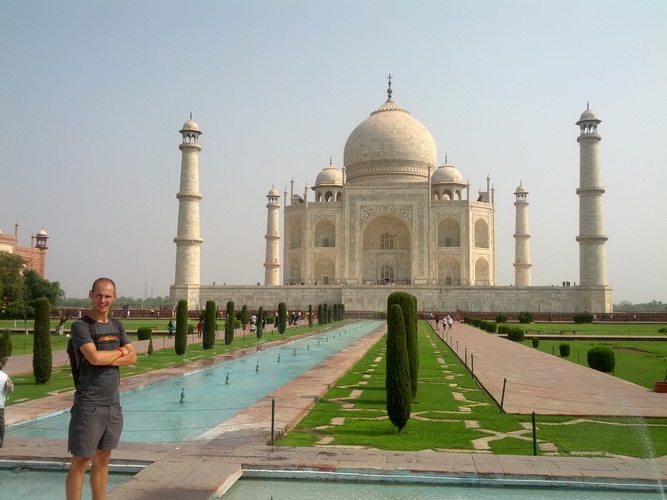Backpacking in India
India is gigantic, India is colourful. But India is also chaotic, noisy and dirty. These and many other attributes characterize one of the most diverse countries on the globe. On your backpacker trip through India you can do trekking and mountaineering in the highest mountains of the world, as well as you can beat through dense primeval forests, where the tiger still lives. India is so diverse that you think you are traveling through different worlds on your backpacker tour. Here the country is ultra-modern and there again archaically backward. Pure luxury and wealth are often confronted with a few meters of deepest poverty, dirt and disease.
Backpacking across the subcontinent, you’ll pass through vibrant cities, encounter numerous cultures and encounter a diverse geography. Experience rough oceans, sophisticated temples, lively markets, lively festivals and enjoy the culinary diversity of the country. More than 1.1 billion inhabitants live in the second most populous country on earth. That is almost four times as many as in all of Europe.
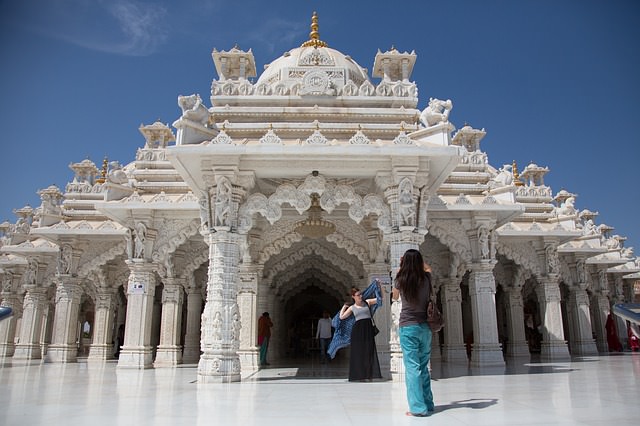
Backpacking in India – Temple
However, you do not have to assume that you will encounter crowds of people everywhere. The majority of the population lives in the fertile plains of the Ganges. In the metropolises Mumbai (Bombay), Delhi and Kolkata (Calcutta) alone live about 40 to 50 million people. But who knows that for sure? If you set out to explore the Himalayan region and the dry regions in the northeast of the country, you will not encounter a soul.
Travelling to India can be arduous and hard, pleasant and easy, depending on the type of trip. That depends on the budget. One thing is for sure, in India you can get through for a button and an egg. There are overnight accommodations for 2 euros as well as delicious meals for a few cents. If you want to live well with your backpacker tour, then calculate about 20 Euro. But it is also much cheaper. Of course also more expensive. Assume that you’ll have to pay far more than the locals for visiting various sights. But this will usually not kill you financially. A visit to the Taj Mahal costs about 9 Euro. But with that you’ve already seen the most famous Indian building. The best way to get there is by train. That is partly comfortable or on the roof also adventurous. The distance from Delhi to Jaipur costs about 6 Euro.
India has some visitor highlights to offer. Take the steepest railway line in Asia from Mettupalayam to Ooty. You make 2203 vertical meters in shortest time. You have to get to know the capital Delhi and the garden city Bangalore. But also Hyderabad, the pearl city, or Varanasi, the holy Hindu city, have their charms. Have a look at Ellora/Ajanta, the temples carved into the rocks or relax with the hippies on the dream beaches of Goa. The golden temple of the Sikh awaits you in Amritsar and in Hampi you will meet the fascinating remains of the former empire of Vijayanagara.
Tradition and culture in India
With the dimensions that the Indian continent encompasses, there is no shortage of a series of cultures that have formed there over the course of time. Basically, one cannot speak of a uniform Indian culture at all, because the cultures are simply too different. In addition, there are the gigantic distances. Who knows deep down in the south what the Scherpas do in the Himalayas in the north? The Indian culture is strongly influenced by the four main religions Hinduism, Buddhism, Jainism and Sikhism. All have left their traces in the form of palaces, fortresses and sacred buildings. You will also discover the diversity of Indian culture through the many cheerful and exuberant festivals that take place throughout the year.
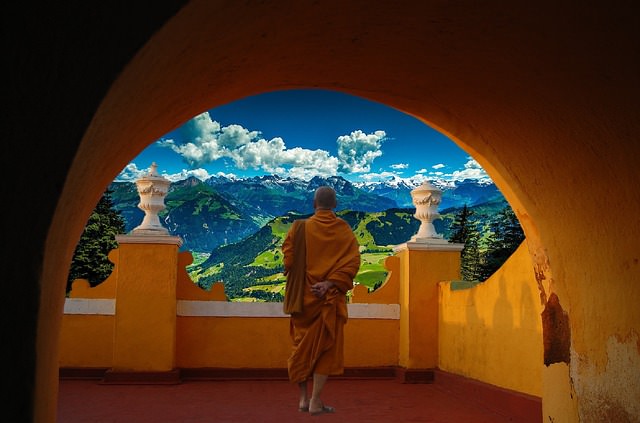
Backpacking in India – Religion
The most famous are: Diwali – the Festival of Lights, Independence Day, Republic Day and Gandhi Jayanti. The many culinary delicacies belong to the Indian culture. But some of them will take your breath away, they are so sharply turned on. What unites India culturally is the film industry Bollywood. Even in the smallest nest the stars of the industry are known. Another common characteristic is respect for the other. At the traditional greeting ceremonies, Indians fold their hands, bow slightly to their counterparts and say Namaste. The custom originates from the Hindus. You don’t have to use it now in the first Indian discotheque.
Backpacker Route in India
As beautiful and varied as the subcontinent may be, you can’t get anywhere without special permits. In any case, make sure that you always have enough time to play, because: sometimes it goes forward, sometimes it doesn’t. For certain destinations in North-East India, with the exception of Assam, you need a Protected Area Permit (PAP). This also applies to the islands and regions Andaman and Nicobar, Jammu and Kashmir, Lakshadweep, Rajasthan, Himachal Pradesh and Uttaranchal.
It’s best to order the visa right away, otherwise you’ll have to deal with the local authorities on the spot. Corruption is known in India. Of course there is a lot to see on your backpacker trip through India. It’s not worth doing the whole country at once, unless you have a lot of time. Better you take parts and discover them intensively. If you only have 14 days, you should at least have a look at the following spots.
Route 1: 14 days India Beginner Tour
- 1 day Taj Mahal
- 1-2 days Hindu cult in Varanasi
- 2 days Tiger Tour in Bandhavgarh or Ranthambore
- 3-4 days getting to know Goa. The Portuguese have left a lot here.
- 1 day Jaisalmer, Rajasthan
- 1 day Rishikesh
- 1 day Chennai
- 1 day Hyderabad
- 1 day Jodhpur
If you can do this is questionable, because the distances are too long. Without flying, bridging the distances costs you a lot of time. But you can try it.
Route 2: Backpacker Intensive India Trip (up to 40 days and more)
We start with the first destinations as above
- 1 day Taj Mahal
- 1-2 days Hindu cult in Varanasi
- 2 days Tiger Tour in Bandhavgarh or Ranthambore
- 3-4 days getting to know Goa. The Portuguese have left a lot here.
- 1 day Jaisalmer, Rajasthan
- 1day Rishikesh
- 1 day Chennai
- 1 day Hyderabad
- 1 day Jodhpur
- 2 days New Delhi
- 2 days Bangalore, Karnataka
- 1 day Khajuraho – the birthplace of Kamasutra
- 2 days Mumbai, Maharashtra
- 2 days Jaipur , Rajasthan
- 1 day Golden Temple
- 2 days Udaipur, Rajasthan
- 1 day Manali
- 1 day Srinakar at Dal Lake
- 1 day Shimla
- 1 day Visakhapatnam (Vizag)
- 1 day Tirunelveli
- 2-3 Days Andamen Island Experience
- 1 day getting to know Jaisalmer in the middle of the Thar Desert
And if you want to get to know the biodiversity of the national parks while backpacking through India, take your time. There are 102 national parks in India. The complete list here.
Travel times in India
As you can surely imagine, one cannot make a uniform statement about the best travel time for such a huge area as India. There is every climate in every season somewhere on the subcontinent. It can be brawny hot in Indian summer. But at the same time on the backpacker trip there is a place in India where it rains or is ice-cold again in summer. The same applies vice versa. You have to look for the ideal backpacking climate for your purposes in practically every region. Roughly the thing looks like this:
Travelling without major weather problems is best from October to mid-April. At this time you enjoy the best visibility in the mountains and the temperatures are relatively pleasant. In regions above 2000 m you better drive from not December to January, unless you love it cold and with lots of snow. From the spring in March the thunderstorms come. But it doesn’t really rain until the monsoon season on June. Exceptions are Kashmir and Ladakh.
Backpacker Budget in India
In India, you can get through cheaply, and that right at the start. Hardly any other country is as cheap to travel to as India. With a budget of 20 euros, you live really well. With less it goes however also. The most expensive entry costs 9 euros for the Taj Mahal. Other sights like the Orchha Temple you can visit for 3€. The entrance to the Jaipur Fort costs about 4 Euro. And these are tourist prices. The locals pay a fraction. For the food you hardly have to put down anything. With 2-3 Euro you can eat your belly full the whole day at street stalls with delicacies. Also the drinks are inexpensive.
Here is a short overview of the situation in Delhi.
- Taxi from the airport to the city around 2,5 Euro 3.25 – 4.88
- Metro from the airport to the city 0,9 Euro
- 3 km taxi ride in Delhi/New Delhi 0,4 – 0,6 Euro
- 3 km Rickshaw ride 0,4 – 0,6 Euro
- Metro ride Delhi hardly measurable
Bus fares and domestic fares in India
Rail travel is the hit in India especially if you want to cover longer distances. You can make yourself super comfortable or travel on the roof. There are a number of ticket categories. How much does the train ride cost on average?
- From Delhi to Jaipur 6 Euro
- From Jaipur to Mathura 2,50 Euro
- From Mathura to Agra 1 Euro
- From Agra to Varanasi 3,90 Euro
- From Varanasi to Jhansi 1,50 Euro
The best thing is to have a look at the following websites. There you will find the prices, the routes and other news and interesting things about train travel in India www.indiarail.gov.in, www.irctc.co.in. Both sides are trustworthy. You can also book online.
Flying in India
Flying is more expensive than taking a bus or train, but it’s not priceless. The route from Mumbai to New Delhi costs between 40 and 70 Euros depending on the season. This can make the backpacker trip a bit more pleasant. From Delhi to Goa you have to pay about 100 Euro.
Bus travel in India
Who wants it hard on his backpacker trip through India, takes the bus. Narrow, stuffy but cheap. Have a look at the websites of Raj National Express and KPN Travels. These are two bus companies that now drive through India in the style of the American and German long-distance buses. There you’ll also find everything about the prices.
The visa costs 65€ for Germans by the way. There are people who travel with 600 to 800 Euro 6 weeks through whole India. This can hardly be done in any other country.
Backpacker Accommodation in India
Travelling in India is inexpensive. If you want to have a really good time on your backpacker trip, plan on 30 Euro per day. But that’s really good then. Even with 20 Euro you can still get through well. Because the food and the overnight stay are often very cheap. If you put down 25 Euros for a hotel room, then you already have air conditioning, cable TV, WLAN and your own toilet included. Traveling through India is on average much cheaper than traveling to South America. But also Southeast Asia is more expensive. There are already simple overnight accomodation possibilities for 3 euro in India. A small beach hut in Goa costs about 10 to 12 Euro. Let’s have a look at the hostel prices. According to Hostelworld these are on average depending upon city as follows. Mind you, on average.
- New Delhi 5 Euro
- Mumbai 7 Euro
- Goa 5 Euro
- Jaipur 4 Euro
- Varanasi 4 Euro
- Agra 3 Euro
- Cochin 4 Euro
- Udaipur 7 Euro
- Jodhpur 6 Euro
Bed and Breakfast in India
An alternative is Bed and Breakfast. This has the advantage that you can stay in a much more intimate ambience with a family connection. The guide with the hot tips is usually still included. However, the thing is a little more expensive at least if you do B and B alone. It’s worth it for two. In New Delhi you pay about 15 Euro for a room. In Goa on the beach with 8 far less. In Jaipur with about 13 Euro again a little more, but in Varanasi with 8 Euro again less. In Agra Bed and Breakfast is also not expensive with 10 Euro. In Cochin you have to pay 12 Euro for a clean room in a private house. Udaipur is with 8 Euro much cheaper than Jodhpur, where you pay 12 Euro.
If you have a bit more budget available, you can also rent a furnished apartment in India for a few days. In Mumbai it costs on average 17 Euro, in Goa 25. In Jaipur you also get through with 15 Euro. In Cochin, however, it is a little more expensive.
Camping in India
Camping is on the rise in India. The best campsites can be found in the best places. And often the tent is already there when you arrive. There are top campsites across the subcontinent. Recommended camps include West Ladakh Camp on the Indus River, Sangla Valley Camping, Watermark Camp on Pangong Lake, Kareri Lake Campsite in Himachal Pradesh and Camp Mashoobra Greens near Shimla.
Backpacker Trips, Tips & Highlights in India
Travelling to India is probably one of the greatest challenges for any backpacker. Simply because you don’t know where to start. It’s hardly worth making India in 6 weeks, you better concentrate on one region and do it intensively. After all, you can always come back again. Enjoy lively bazaars and pompous elephant parades. Take a look at sophisticated golden temples and discover the magnificent marble mausoleums. No matter where you are on the subcontinent, there’s always something to see.
You can plunge into the hustle and bustle of the big cities of Mumbai or Delhi or hang out in Goa with the hippies and dropouts on the dream beaches. The absolute Indian highlight is the Taj Mahal in Agra, built by the Indian Groβmogul Shah Jahan. The megalomaniac was saddened by the death of his favourite wife. UNESCO also thinks the mausoleum is good. It now belongs to the UNESCO World Cultural Heritage. You should have a look at the Red Fort in Delhi, built of sandstone. Inside, you’ll see the largest mosque in the world.
For the Sikhs, the Golden Temple in Amritsar is the largest sanctuary. Keep your camera ready, it’s worth it. Already the harem women of different moguls enjoyed the palace of the winds in Jaipur. But they were trapped in it. You can take a free look at the monumental building. Take a trip on the holy river Ganges and make a detour to the Hindu town of Benares. The “blue city” Jodhpur, in which the magnificent Umaid Bhavan Palace rises, certainly seems a bit bizarre to you. Also the natural aspect should not be ignored during your backpacker trip through the country. After all, there are over 100 national parks you can visit.
Backpacker Highlights in India
A yoga course in Haridwar and Rishikesh is one of the real India hits. And if you want to know more about Ayurveda, Kerala is the place for you. Take a cooking course and learn authentic Indian cooking. The best place for this is in Punjabi. You should try a mango based Cola Maaza. How you have to enjoy the Indian cuisine in all its facets.
You can also bring great souvenirs from the country. Wood and stone carvings, but also first-class inexpensive clothes made of wool and silk are worth it. Cashmere clothes from manufacturers. Where can you find them? Make sure you’re in Goa at carnival time. That’s where it really happens. There is also a lot going on in many parts of India during the Holi Spring Festival in March or April. In October/November the festival of lights Diwali “Diwali” is celebrated. If you know the rules of cricket, then visit a game of the first league. There are 50,000 spectators. In the Eden Gardens cricket stadium in Calcutta 90 000 fit in. All hell is breaking loose. Sure, and driving a train on the roof is a must anyway when backpacking through the subcontinent. If you still have enough money, then take a ride in a luxury train like the Maharajas’ Express.
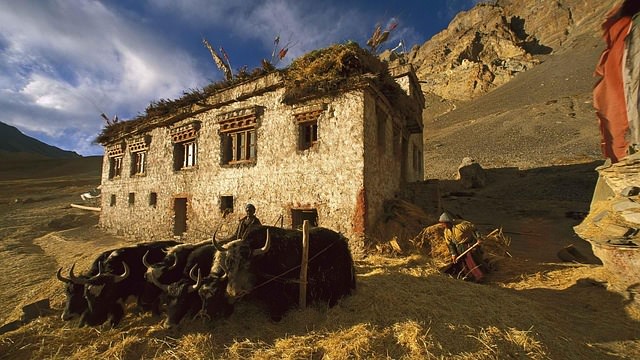
Backpacking in Indien – Villages
Backpacker Insider Tips in India
The country has so many visitor highlights to offer that it is difficult to say what is an insider tip. Nevertheless, if you go off the beaten track to explore the country, you will really get to know it. Head to the mogul town of Fatehpur Sikri, which was inhabited only a few centuries ago. It still stands like new. Rent a houseboat or even a boat and explore the backwaters. You are in an unmanageable network of artificially constructed canals of well over 1,000 kilometres in length. At India’s second highest mountain, Nanda Devi, the “Valley of Flowers” awaits you. The remote Kutch region of Gujarat is known as the Wild West. There are even salt deserts there. In Meghalaya, in the northeast of India, you’ll find one of the wettest areas in the world. Also a great experience.
The largest inhabited river island in the world is called Majuli and is located in the Brahmaputra River in Assam. It is said that a world of its own has formed here. If the tourist hype in Varanasi is too much for you, then visit the much quieter alternative Maheshwar on the Narmada River. Also a Hindu sanctuary. Do you want to experience a real adventure that few have ever undertaken? Then head to the small town of Kalap, a few thousand meters high in the Garhwal region of northern Uttarakhand. Only an expedition will get you there. There are no roads.
Food & Drinks in India
To analyse the cuisine and the variety of recipes in India would take an entire book. The complexity and variety of the compositions of the dishes in the different regions is so different that one can already speak of one’s own cuisines in the north and the other cardinal points. But what they all have in common is the use of different spices, including pepper, turmeric, cardamom, curry and many more.
Food in India
As in the rest of the world, the staple foods are rice, wheat and pulses. But not every staple food is consumed the same way everywhere. While in the north a lot of wheat is used as the basis for dishes, in the south it is rice around which many recipes are built. On the coasts, fish and seafood are added. And then, thanks to the tropical and subtropical regions in which India spreads, there is a multitude of fruits. Of which, however, the high mountain dwellers have little.
You will find pita bread everywhere in the wheat region during your backpacker trip. Chapati, Roti, Puri or Naan are other types of bread and dough. In the rice region, many dishes are based on the aromatic Basmati rice. You have to take a close look at the meat thing. Because despite widespread opinion Indians eat meat. Goat or lamb meat is eaten everywhere. The fact that Indians do not eat beef is only partly true. Only for the Hindus the cow is holy, for the Muslims it is the pigs. It depends therefore always on where and with whom one wants to eat. Venganers, vegetarians and all others who do not eat meat at all are right in India. Many ascetics and religious groups completely reject the consumption of meat in India.
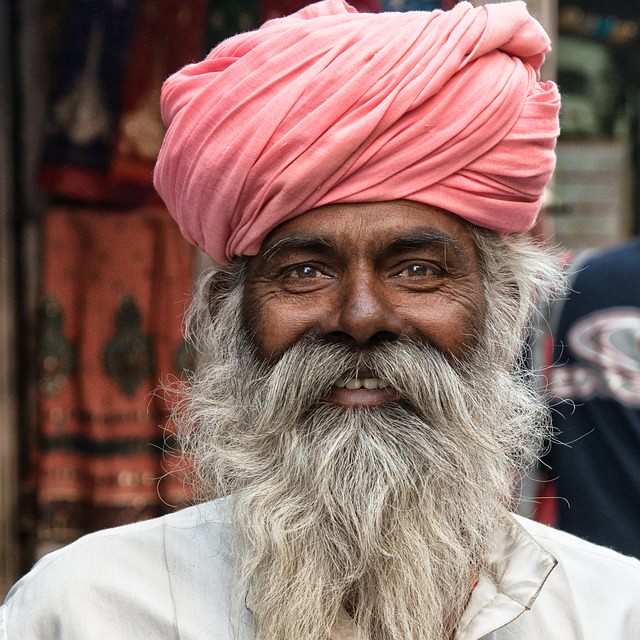
Backpacking in India – People
In the Bengali cuisine there are many sweet delicacies, in the south there is a lot of coconut pulp, also in the form of coconut milk or coconut oil, used in the dishes. You should know that in many regions the cuisine of the former colonial powers has also crept in. In Goa, for example, Portuguese cuisine.
The most famous dishes are the curries. Some are super hot. Many dishes also contain clarified butter ghee. Panir cream cheese is also widely used. Sambar is a strong lentil dish and Biryani a rice dish. Samosa are delicious dumplings filled with different kinds of dough, which can be bought cheaply at many street corners. If you have the opportunity to eat a Halva, then you enjoy a special nougat.
It is not worth visiting the international fast food chains in the big cities. Only the well-heeled middle and upper classes, who have fallen for the marketing of the chains, spurn the better and inexpensive own kitchen for an expensive burger.
Drinks in India
Tea is a national drink in India. The Chai is available in many varieties. The Masala Chai, which is enriched with milk and cardamom and ginger, tastes good. The Indians also mix such spices into the coffee. Something really delicious are the mango-based juices Maaza, which are also bottled by Coca-Cola. The competing product Slice comes from Pepsi. A classic backpacker in Southeast Asia is the yoghurt drink Lassi. If you pour yourself Toddy, then it is a fermented palm juice.
Beer and wine
India has its own wine and beer culture. The Indian Pale was brewed a hundred years ago. You can also try the Kingfisher and Golden Eagle beers. If you want more effect in the pear, use the strong beers like Godfather and Thunderbold. You should only drink bottled or boiled water.
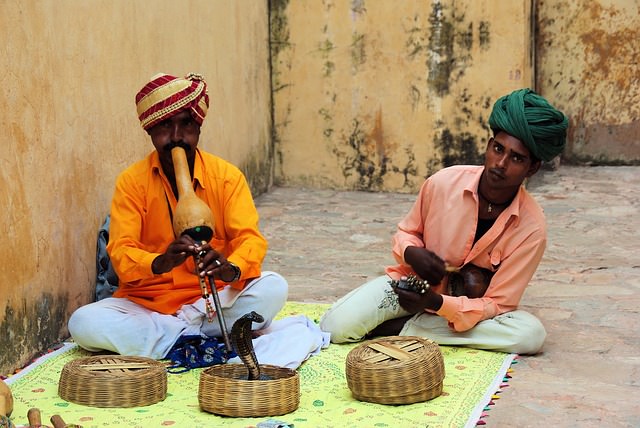
Backpacking in India – Snake Charmer
Backpacker Visa and Vaccinations in India
According to the German Foreign Office, the entry requirements for German citizens are currently as follows for India:
- Passport: Yes
- Provisional passport: Yes
- Identity card: No
- Temporary identity card: No
- Children’s passport: Yes, with photo
A still valid child ID according to the old model should still be valid, but you better not risk it. Every child needs his or her own ID document.
Visa and medical information
You cannot enter all regions of the country. For this you need a special permit. But you can apply for a special permit when you apply for your visa. Since 27.11.2014 it is possible for German passport holders to obtain a special tourist visa on arrival in India (“Tourist Visa on Arrival”) after applying for an “Electronic Travel Authorization” (ETA). Nevertheless, it is better to ask at the consulate first, as there is no experience with this yet.
Vaccinations
If you are entering from countries where polio is prevalent, you must provide proof of vaccination. The same applies to money fever areas. It is in your own interest to update the complete vaccine protection. Malaria occurs all year round with seasonal fluctuations. You are only safe from 1 500 m above sea level. Diarrhoea, colera, rabies, dengue, tuberculosis, chikkungunya, Japanese encephalitis, bird flu (influenza A H5N1) occur regularly in India.

